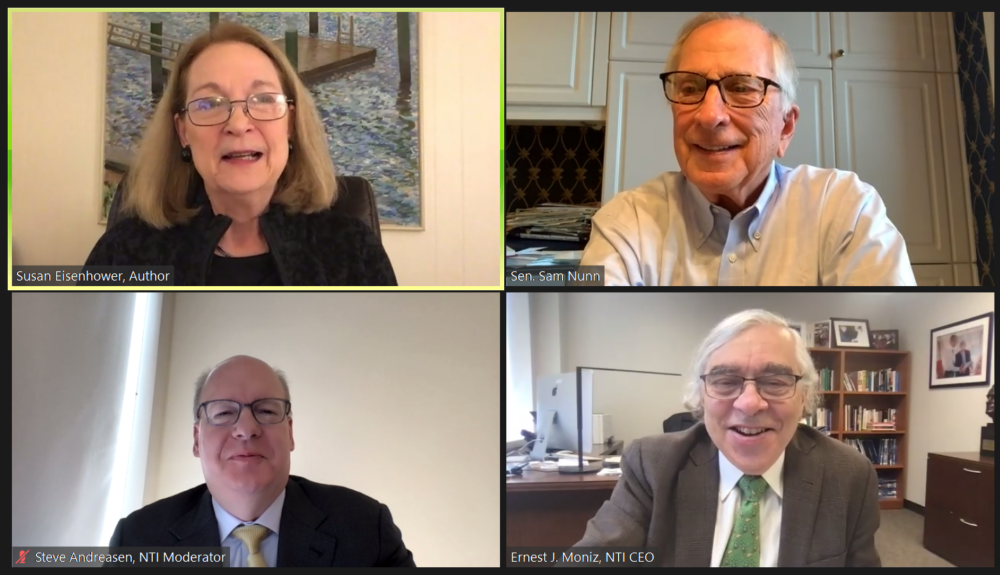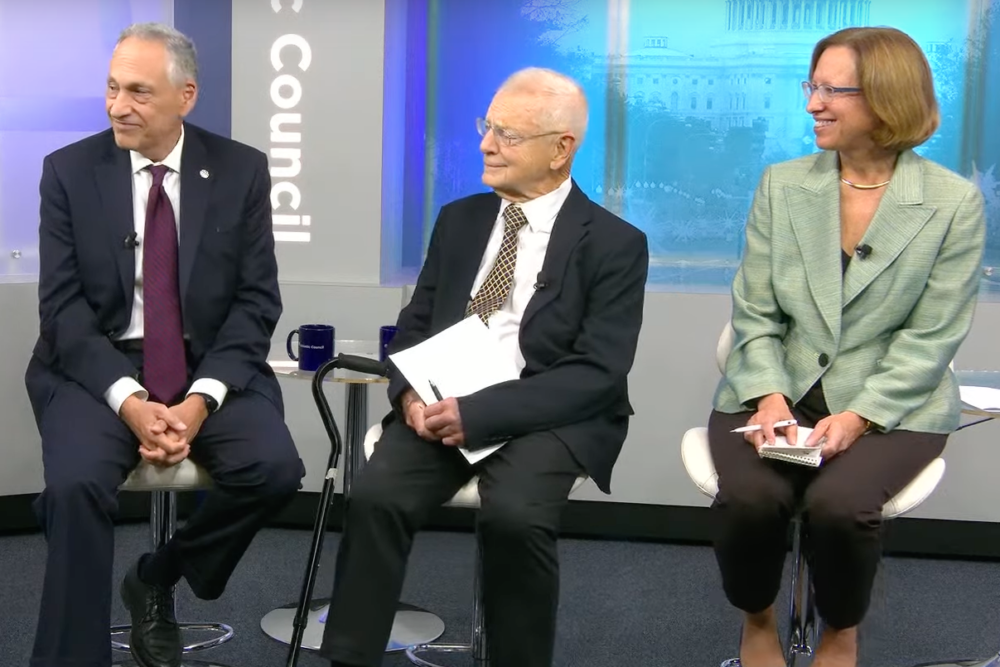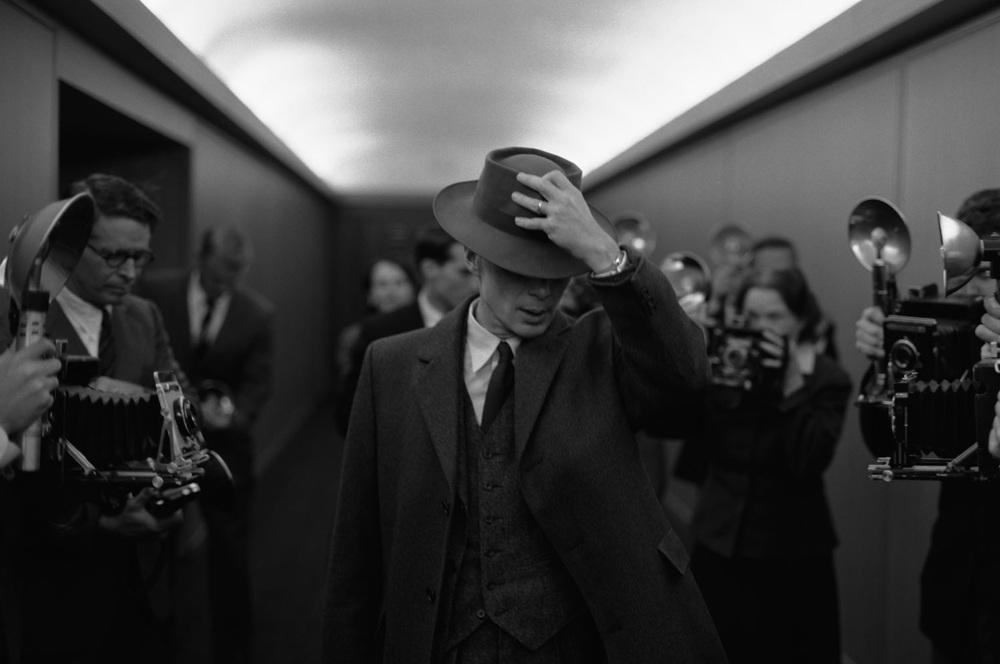
Christopher Colletta
Consultant
Atomic Pulse
From D-Day to Little Rock, from the Korean War to Cold War crises, from the Red Scare to the Missile Gap controversies, few people have made decisions as momentous as Dwight D. Eisenhower. In a virtual NTI Seminar on Sept. 22, Susan Eisenhower, founder and chair emerita of the Eisenhower Group, Inc. and NTI board member emerita, joined NTI Co-Chair and CEO Ernest J. Moniz to discuss her new book, How Ike Led: The Principles Behind Eisenhower’s Biggest Decisions. A retrospective of Eisenhower’s wartime and presidential leadership, How Ike Led is part leadership book, part history, and part memoir, with new insights on the man from a family member and national security expert. The book shows us not only what he did, but how—and what we can learn from him today.
In a discussion moderated by Steve Andreasen, NTI national security consultant and adjunct faculty member at the University of Minnesota’s Hubert H. Humphrey School of Public Affairs, Susan Eisenhower first laid out why she wrote the book. “I would say that we’re in the middle of a leadership crisis, and we’ve come to the point where we think leadership is all about transactional decision making,” she said. “Actually, it’s about a lot of things, including character and an ability to think about problems in the right way.” Although everyone has their own way of doing that, her grandfather had a distinctive ability to “strip problems down to their essence” and apply a set of principles to solving them which are themselves the true subject of the book, she added.
The “How” of Ike’s biggest decisions
While military historians focus on his role in World War II and presidential historians focus on his time in the White House, Susan Eisenhower adopted a thematic approach to illustrate how Eisenhower the general and Eisenhower the president were one and the same. Although he resigned his commission to reluctantly run for president of the United States, “he was still someone who thought like a general, somebody who was used to making exceedingly difficult decisions in a short period of time with inadequate information,” she said. Once in the White House, however, she noted that he was able to use “patience and other tools in a strategist’s toolbox” allowing situations to develop before having to make a decision, a relative luxury he did not always have while in uniform.
Succinctly describing the level of discipline that Eisenhower carried throughout his military career and into his time as the 34th president, Susan Eisenhower chose “accountability without caveats” as a title of one of the book’s chapters. It was this discipline that guided him through his career of many “firsts.” From stemming a viscous outbreak of the Spanish Flu while being the first-ever Army tank corps commander to managing, as president, the newly developed and unimaginably powerful hydrogen bomb that “made novices out of everyone,” he consistently faced problems that had never been seen before. It was because of all this, perhaps, that Eisenhower often gave great praise in his journals and letters to those who were “imaginative”—he himself had to be extraordinarily creative to be successful.
Dwight Eisenhower’s lessons for today’s leaders
During his first year in office, President Eisenhower delivered his famous “Atoms for Peace” speech that was a precursor to the creation of the International Atomic Energy Agency (IAEA) and, later, the Nuclear Non-Proliferation Treaty (NPT). Both the IAEA and NPT remain core components of the global nuclear nonproliferation regime, and Moniz asked Susan Eisenhower how she thought his initial vision still resonates given the benefits and disadvantages nuclear technology continues to confer on the world today. She explained how Atoms for Peace was a set of blueprints, not a set of instructions, and how one of the crises we face with our own leadership is that we rarely go back to the principles that guide the initial development of our policies. These days, she said, policies are pulled in one direction or another based on whatever political conversation is occurring in the country at the time.
Andreasen fielded questions from the audience, focusing on how Susan Eisenhower thought her grandfather would approach certain problems today. Specifically, he asked how Eisenhower would view the U.S.-Russian relationship. Today’s Russia is neither the Soviet Union nor the Russia of the 1990s, she noted, but the parallels are evident recalling that Eisenhower expressed dismay at how “we have allowed ourselves to end up in a really dangerous situation where we have so few contacts today between our two countries.” Eisenhower entered the White House under similarly dire circumstances but worked hard to broaden engagement between the United States and the Soviet Union. Susan Eisenhower expressed surprise at the amount of exchange he encouraged through the People to People program in 1955, how Russians could learn about America through the newly formed U.S. Information Agency, and how he ensured American and Soviet scientists got to know each other through the Atoms for Peace conferences. These days, Susan Eisenhower said, “the situation could not be any worse in terms of having an unknowable adversary under dangerous conditions.”
The “vivid and the vital”
Reflecting on the discussion, NTI Co-Chair and former Senator Sam Nunn noted how President Eisenhower was consistently able to avoid the trap that today’s American policymaking establishment seems stuck in: prioritizing the “vivid” over the “vital.” Susan Eisenhower agreed, describing how leaders must get better at determining which national security threat is “the long pole in the tent,” and how her grandfather was able to do so by following the “middle way” between the extremes of contemporary political discourse. In the end, she said, “if he managed to make the [tumultuous] 1950s look like the era of Elvis Presley” and rock and roll, “he fulfilled his mission.”
How Ike Led: The Principles Behind Eisenhower’s Biggest Decisions was published in August 2020. More details about the book can be found here.
Sign up for our newsletter to get the latest on nuclear and biological threats.
Lynn Rusten, vice president of NTI’s Global Nuclear Policy Program, shares her reaction to the 2023 Strategic Posture Report during a panel event at the Atlantic Council.
Considering the current nuclear landscape, the power of Christopher Nolan’s film and the moral and ethical questions raised by J. Robert Oppenheimer’s work, movie viewers may be motivated to act to advocate for a world without nuclear weapons. But how?
If you want to learn more about Oppenheimer’s bomb and what we must do to protect the world today and for future generations, NTI’s online library is the perfect place to go.



